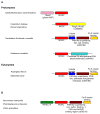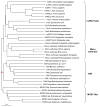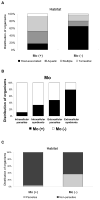Comparative Genomics and Evolution of Molybdenum Utilization
- PMID: 22451726
- PMCID: PMC3311541
- DOI: 10.1016/j.ccr.2011.02.016
Comparative Genomics and Evolution of Molybdenum Utilization
Abstract
The trace element molybdenum (Mo) is the catalytic component of important enzymes involved in global nitrogen, sulfur, and carbon metabolism in both prokaryotes and eukaryotes. With the exception of nitrogenase, Mo is complexed by a pterin compound thus forming the biologically active molybdenum cofactor (Moco) at the catalytic sites of molybdoenzymes. The physiological roles and biochemical functions of many molybdoenzymes have been characterized. However, our understanding of the occurrence and evolution of Mo utilization is limited. This article focuses on recent advances in comparative genomics of Mo utilization in the three domains of life. We begin with a brief introduction of Mo transport systems, the Moco biosynthesis pathway, the role of posttranslational modifications, and enzymes that utilize Mo. Then, we proceed to recent computational and comparative genomics studies of Mo utilization, including a discussion on novel Moco-binding proteins that contain the C-terminal domain of the Moco sulfurase and that are suggested to represent a new family of molybdoenzymes. As most molybdoenzymes need additional cofactors for their catalytic activity, we also discuss interactions between Mo metabolism and other trace elements and finish with an analysis of factors that may influence evolution of Mo utilization.
Figures








References
-
- Rajagopalan KV, Johnson JL. J Biol Chem. 1992;267:10199–10202. - PubMed
-
- Hille R. Chem Rev. 1996;96:2757–2816. - PubMed
-
- Schwarz G, Mendel RR. Annu Rev Plant Biol. 2006;57:623–647. - PubMed
-
- Mendel RR, Bittner F. Biochim Biophys Acta. 2006;1763:621–635. - PubMed
-
- Mendel RR. Biology J Exp Bot. 2007;58:2289–2296. - PubMed
Grants and funding
LinkOut - more resources
Full Text Sources
Other Literature Sources
Research Materials
